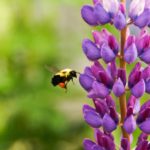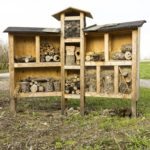
Honeybees and other pollinating insects and birds are critical in providing us with many of the foods we eat every day. According to the Natural Resources Defense Council, out of 100 major food crops, 70 are pollinated by bees.
But this essential insect is on the decline. One factor is that bees are suffering from the loss of habitat, causing them to work harder, and travel further for food sources.
Here are 5 tips to create the perfect environment for these busy little bees to thrive in:
 Flowers vs. Grass:
Flowers vs. Grass:
Consider creating flowerbeds on a part of, or most of your lawn, which provides the diet and habitat for honeybees and other pollinators. And don’t forget the added benefit of less mowing!
- Native Flowers:
Native species of flowers are uniquely adapted to your region, which also means the bees have adapted especially well to these plants. The Pollinator Partnership and NAPPC have published this handy guide to “Selecting Plants for Pollinators”. - Season-round blooms:
Plants that provide nectar and pollen throughout the growing season are the best choices. As a result, you may need to choose three different blooms for spring, summer and fall, so bees have a constant food source.
three different blooms for spring, summer and fall, so bees have a constant food source. - Bee Homes:
Some pollinator bees, like the Mason bee, need water and mud to make their homes. While others like wild hedgerows, piles of brush and other dead plant material for nesting. Leaving areas of your yard “unmanicured” will provide little habitats’ for these pollinators to thrive. - Don’t forget Fruits & Vegetables:

Fruit and vegetable bearing plants are adored by pollinators and have the added benefit of providing a tasty treat for you as well!
Modern Pest Services recognizes the importance of honeybees to the environment and we share the growing concern about pollinator health. Rest assured, when Modern encounters a beehive where it is not welcome, we help to find a local beekeeper to safely remove the hive for relocation.
Additional blogs on Natural Pest Control: 5 Flowers For Your Garden
Modern’s approach to managing pest issues in your home does not include blindly following a pesticide application schedule, as many would imagine. Instead, we first look at physical means of eliminating or discouraging pests, only using a very targeted application of products when necessary. We have an ongoing commitment to using the latest knowledge and methods to control pests in a way that has the least impact on health–whether of people or of the environment.
If you do encounter a hive on your property, consider calling a professional at Modern Pest Services, to help you safely relocate the hive.
Like this article? Sign up for our monthly newsletter to read the latest news on keeping your family and home safe from disease carrying pests. Discover new tips to stay pest-free and get special offers and discounts.
